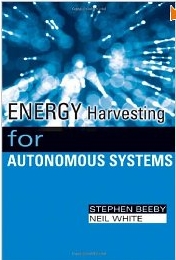Energy Harvesting for Autonomous Systems by Stephen Beeby, Neil White
ISBN 1596937181 – 292 pages $120 on Amazon Published June 30, 2010
While on the surface this book may not seem directly related to nanotechnology, a number of the chapters discuss photovoltaic cells, MEMS piezoelectric / electrostatic generators and related refinements (such as textured anti-reflective Si surfaces and organic polymer PV cells) that do fall in the nanoscale regime.
This text does several things well: it compares and covers a number of different types of energy scavenging, illustrations of and helpful reference tables are fairly abundant, and there are enough formulas present to help anchor the relevant math to practical applications.
Furthermore, the end chapters deal a lot in the interface electronics and energy storage mediums such as microbatteries and supercapacitors so that reading the text can help outline an entire research project or product idea.
But the book does have some nagging detractions:
1) The material seems a little too thin in parts. (scaling it up by 2 or 3 times could make it an excellent reference bible)
2) With a little more effort the included formulas and math would be much easier to follow if the constants used were clearly explained in a small sidebar or table instead of having to decode the symbology by constantly referring back to the expository text which is often BOTH above and below said formula. This is very irritating as you have to move your eyes in all directions around the equation without knowing where to expect the explanation of “C sub f ” followed by another hidden object game.
As Western readers, we are used to a smoother linear flow from left to right and up to down. Some may claim you should already know what Qgs means, but the book spans topics from thermodynamics to semiconductor physics and as engineers/physicists, etc. we are all painfully aware of how “overloaded” and cross-translational some math symbology already is.
To be really innovative, I would like to have seen more of the formulas COMBINED with the illustrations so as to better anchor intuitive and visual understanding of the math.
3) Not surprisingly, a lot of the applications are geared towards wireless sensor networks. I would like to have seen some broader visions than just this, but it is not hard to translate the concepts across. Finally, the book only mentions microcontrollers in passing – some stronger information than two paragraphs on Texas Instruments MSP430 could have been warranted, but it is easy to see how a publication can lose focus if it tries to cover every aspect in detail.
But one thing I learned is that up until very recently, there have hardly been any texts at all dedicated to energy harvesting. Most of the material is scattered across publications and conference proceedings and it is really nice to see a resource that puts a lot together at your fingertips.
The strongest thing about this book is that it does not only help develop some intuition for the expectations and limitations of different harvesting approaches, but it also builds the bridge concepts to extrapolating the technology to the macro real world. As it stands, it could be a decent starting text for a single semester class in Energy Harvesting, but some supplementary information would almost certainly be required – particularly if taught at the grad level.
